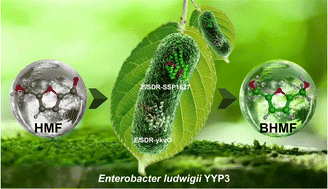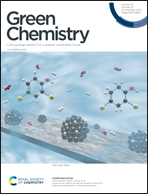Insights into the molecular mechanism of a new efficient whole-cell biocatalyst Enterobacter ludwigii YYP3 in 5-hydroxymethylfurfural reduction†
Abstract
Upgrading of the bio-based platform chemical 5-hydroxymethylfurfural (HMF) into high-value derivatives is an important research topic, particularly in green and sustainable chemistry. Herein, we applied a new, highly HMF-tolerant strain, Enterobacter ludwigii YYP3, as a whole-cell biocatalyst for efficient reduction of HMF to 2,5-bis(hydroxymethyl)furan (BHMF). Upon process optimization, within only 3 h, BHMF was produced with a yield >99% and 98.5% selectivity using 100 mM HMF, resulting in the highest space time yield (4.2 g L−1 h−1) among the currently reported HMF bioreduction processes. In a fed-batch conversion, E. ludwigii YYP3 achieved large-scale production of 290 mM BHMF within 9 h and retained its high catalytic activity for three runs (27 h), suggesting an excellent cycling stability. Based on genome and transcriptome analysis, the molecular mechanism underlying the high HMF tolerance of E. ludwigii YYP3 was explored, primarily through the downregulation of genes related to amino acid biosynthetic and metabolic processes and upregulation of genes associated with DNA replication, recombination, and repair; biofilm formation; and redox homeostasis. Meanwhile, two novel short-chain dehydrogenase/reductase family oxidoreductases ElSDR-ykvO and ElSDR-SSP1627 were identified as target enzymes responsible for conversion of HMF to less toxic BHMF in E. ludwigii YYP3. Combined with structure and mutation analysis, the catalytic mechanisms of target enzymes were determined to be based on the active sites Ser, Tyr, and Lys. Our work not only confirms that E. ludwigii YYP3 has promising application prospects in large-scale production of BHMF, but also provides novel insights into understanding the molecular mechanism of HMF reduction.

- This article is part of the themed collection: Biocatalysis: A cross-journal collection


 Please wait while we load your content...
Please wait while we load your content...